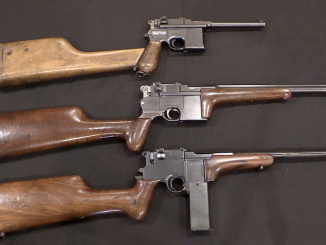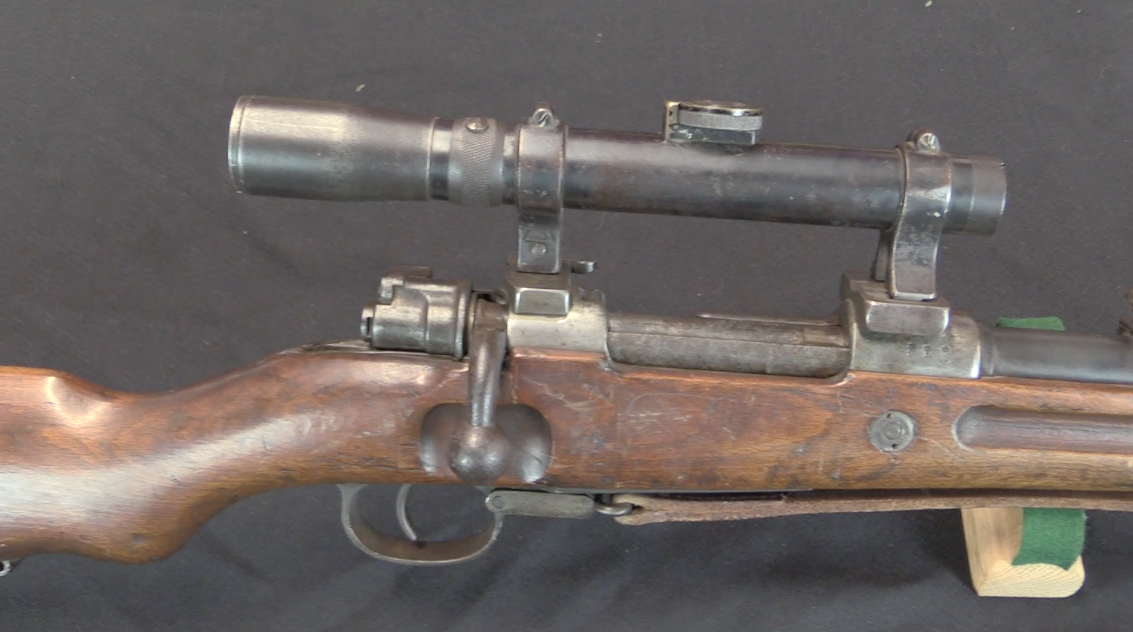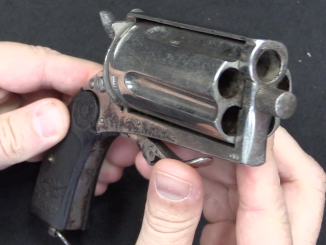This is a reposting of a video from September 2016 with a new introduction. The recent publication of the new and expanded edition of Hans-Dieter Handrich’s book “Sturmgewehr!” has revealed new information about the history of this rifle which I wanted to put into the video. For the record, this rifle sold for $63,250 back in September 2016.
German arms development during World War II was quite the chaotic mess, in many ways. This Gustloff rifle program was initialed after a June 1942 meeting at which Hitler authorized continued development of the Maschinen Karabiner concept on the condition that it was done with the 8x57mm cartridge. Of course, this was doomed to failure, because the concept required easily controllable fully automatic fire from the shoulder, which was simply not possible with 8x57mm. However, the program to develop a stamped, select-fire MKb was contracted to the Gustloff firm anyway.
There were several reason why this was done. First, it would give cover to the continued 8×33 MKb-42(H) development since a rifle-caliber weapon was also now in development. Second, when it inevitably performed poorly at accuracy trials, it would make the 8×33 rifles look good by comparison. Third, by giving the well-connected Gustloff company a development contract, it would relieve some political pressure on the ordnance department. The expected trials never happened, though, because by January of 1943 it was clear that the rifle would take far too long to have ready for production, and the program was cancelled.
Two versions of the weapon were made by Gustloff, refered to by the company as the model 206 (semiauto only) and 208 (selective fire). they were largely sheet metal rifles with a gas piston operating systems and an unusual vertically traveling locking block, akin to the Type 94 Nambu and Bergmann 1910 (as well as the much more recent Arsenal Strike One). They were fed from MG-13 box magazines – cut down from 25 rounds to 10 rounds capacity on this example.
For more information on the development and context of the Sturmgewehr rifles, I highly recommend “Sturmgewehr! From Firepower to Striking Power” by Hans-Dieter Handrich.




“They were fed from MG-13 box magazines – cut down from 25 rounds to 10 rounds capacity on this example.”
Shouldn’t be MG 13?
Anyway that 13 is supposed to be suggesting 1913 year, when in fact that weapon was adopted in 1932. It was backdated to look like it do not break Versailles treaty conditions.
http://modernfirearms.net/machine/de/mg-13-e.html
Yes they were fibbing about development dates. So long as nobody physically dug through the workshop notes who’s going to call out the management? And development dates generally do not dictate time of adoption. For all the Allies cared, the MG 13 could have sat around in prototype form for 19 years and not have been as young as it appeared (we know the developer lied about the design’s age, but the authorities didn’t do background checks very well). I wonder if the STG-44 mirrored the later M16 in that both were adopted after their predecessors failed at intended tactical use. I refer to the problem of the M14, meant to give tactical flexibility and punching power at the same time (something like the case of the FG-42, which was Luftwaffe exclusive and hardly a universal weapon)… I could be wrong on multiple counts.
“M16”
History here is complicated: http://modernfirearms.net/assault/usa/m16-m16a1-m16a2-m16a3-e.html
This weapon, was initially supposed to be stop-gap solution before SPIW (Special Purpose Individual Weapon) matured, but that never happened.
Due to occurrence of various factors it entered wider production, most notably due to course of Second Indochina War and fact that M14 was discounted and mentioned SPIW not ready to production, additionally environment encountered during that war was mainly jungle, where long range provided by 7,62×51 is superfluous and “scatter” (or “spray”) type weapons have advantage.
They aren’t even good a spraying.
“They aren’t even good a spraying.”
I don’t understand. They = M16 rifle or something else? Why not?
“when it inevitably performed poorly at accuracy trials, it would make the 8×33 rifles look good by comparison”
Interesting method of persuading. Anyway I heard that Hitler was convinced for intermediate cartridge after talking with some soldiers which fought on Eastern Front and used it. I am not sure whatever it is true or not, and if true when it happened.
How did German high command officers evaluated intermediate cartridge concept?
Development of intermediate cartridges was in progress in Germany, France and Great Britain during the 1920s. Contrary to popular belief, all the armies that had fought World War One understood that the day of the bolt-action rifle firing the full-power cartridge was over, having been a development intended for colonial warfare to begin with. And even there it had largely been superseded by the heavy machine gun. The armies sensibly concluded that the infantry needed a lighter weapon, that could generate a higher volume of fire, but wouldn’t generally need to be effective much beyond 250-300 yards.
The major reason that nobody went into World War Two with a true “assault rifle” was the Great Depression. Governments just didn’t have the money to replace perfectly-serviceable rifles, no matter how “impractical” they were for actual European warfare. And nobody was up for changing over to completely new cartridges because of the cost of literally rebuilding their ammunition industry.
If not for the economic issues, almost everybody would have gone into 1939 with at least self-loading rifles like the Gustloff, firing rounds in the general size and ballistic range of the 6.5 x 55 or 7 x 57 Mauser cartridges.
The U.S. came closest, with the original Garand chambered for the .276 Pedersen cartridge. But it ended up as a .30-06 purely to avoid the expense of retooling the ammunition industry.
One side effect of this was the almost universal adoption of sub-machine guns firing existing pistol cartridges in the 1930s. No major ammunition retooling needed, and if they weren’t effective out to 250, at “trench fighting” and “street fighting” ranges they were more than sufficient to the job. They were also significantly cheaper to make than a self-loading rifle, a fact that is often overlooked.
BTW, according to the photographs in the 9th edition of Small Arms of the World, the .276 Garand would have been somewhat slimmer and lighter than either the .30-06 version or the later M14 in .308. So even as a purely semi-automatic arm, it was approaching the concept of a lighter weapon later to result in the M1 carbine.
cheers
eon
Those tabs at the end of the breech block serve to prevent bolt bounce. This feature would be vital in this design as the locking block needs to have the breech block to be stationary in battery to move into its locked position.
They also couple the bolt to the operating rod to drive the bolt forward. As they flip up to lock the bolt against bouncing, they’re also decoupling the operating rod so it can continue forward and cam the locking block down.
I do like the operating/locking system here, though I could do without that weird trigger group.
Maybe it was something to do with frost… Deep cold, wood was better.
About that trigger group…
Mostly it’s just weird, but part of it — the front end of the sear, and the way it engages the hammer — is very familiar. That part’s almost exactly the same as in an AR-10/15 trigger group.
Of course the rest is totally different; the AR trigger is one piece with its sear, and the disconnector is basically one half of a Garand- or AK-style double-hook setup, rather than this… pile of German weirdness. But with the sear and hammer, the resemblance is uncanny.
I can’t rule out coincidence (especially after we just saw that Fosbery shotgun with its multi-lug bolt and plunger ejector), but it sure looks like a direct influence to me, especially considering that the sear engagement always struck me as the weirdest thing in the AR trigger group. Does anyone know where Stoner got the idea from, or know of any other guns that copied this? (Or for that matter, if this trigger group was itself a copy of or inspired by something else Stoner is more likely to have examined?)
The locking mechanism is a copy of the Simonoff Russian rifle. The rifle has a
good write up in one of the 21st Army Group technical reports
“Simonoff Russian rifle”
In English it is rendered Simonov, in Deutsch Simonow, however possibly that back then other rules were used. At first glance I though it might be originally from Suomi source (recalling Talvisota-era song Njet Molotoff) but it seems (after looking in SKS article in Suomi wikipedia) that Suomi version is also Simonov.
Anyway Simonov rifle production ended yet in 1940 and decision in favor of self-loading rifle rather than selective-fire “for everyone” was done earlier.
Anyway swapping w or v to ff might be done unintentionally, as historical tidbit of name deformation see example:
http://tankarchives.blogspot.com/2016/11/general-chirmen.html
where M4 Sherman is called 31-T General Chirmen
“this was doomed to failure, because the concept required easily controllable fully automatic fire from the shoulder, which was simply not possible with 8x57mm”.
This comment is a bit interesting, why would a powerful rifle cartridge then be fine for the FN FAL (.308 Winchester and not reckoned as an assault rifle cartridge)? We were issued with it in my army days and it is a weapon most of us preferred to the weapon which replaced it using the less powerful (stupid) .223. Given the FN Fal was a handful on full auto from the shoulder, but nobody moaned really.
You forget that the FAL was designed from the very start based on research of captured STG-44’s. Making a fully automatic rifle using “traditional” rifle layout would result in the Browning M1918 and the Breda PG. Both suffered from recoil-induced muzzle-rise and were terrible in terms of auto-firing ergonomics (as Denny can attest to the latter). The FAL, the CETME, the AR-10 (and onward), and the AK family were designed for ergonomic handling during full-auto shooting. Nobody moans about a rifle that behaves like it should. Seriously, had the FAL been designed for 8×57 IS, I’m pretty sure it would have behaved better than the FG-42… Or am I wrong?
One can safely say that the Germans were ahead in the race towards putting an assault rifle in the hands of the ordinary soldier, despite their stupid leader who had the time for micro management like meddling in cartridge size. What begs the question is how stupid the leaders of the other participants were that they didn’t even fielded an assault rifle.
Well, in Soviet Union serious resources were allocated to development of not only avtomat but also inter-mediate cartridge machine gun (finally RPD was chosen) and inter-mediate cartridge self-loading carbine (SKS). Early versions of RPD and SKS was actually used by Soviet forces during World War II, although in limited numbers – it was testing in combat environment. There was not need to large-scale introduction of inter-mediate cartridge weapon in Soviet forces, as available weapons were good enough, tide of war turned in favor of Soviet Union and most notably other types of armament (and ammunitions) needed upgrade more, for example AT weapons and armor-piercing ammunition for existing field guns to counter thicker armor of new German tanks.